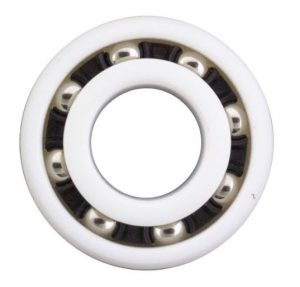
Ball bearings are found in many consumers and commercial products. As the name suggests, they are bearings that contain balls. Ball bearings are designed to reduce friction while simultaneously supporting a load. You can find them in engine shafts, centrifugal pumps, locomotive axles and even computer hardware. While there are different types of ball bearings, most of them consist of three basic parts, which include the following.
#1) Balls
All ball bearings have balls. The ball bearing in the adjacent photo, for instance, has eight balls. Other ball bearings may have more or fewer balls. The purpose of the balls is to transmit a load. When exposed to a load, the balls will rotate to reduce friction and transmits the load.
Some of the most common materials in which these balls are made are:
- Acetal
- Glass
- Ceramic
- Nylon
- Polypropylene
#2) Races
In addition to balls, all ball bearings have races. Races are the pathways or passages that contain the balls. Ball bearings have an inner race and an outer race. As you may have guessed, the inner race is the innermost pathway, whereas the outer race is the outermost pathway. The races typically have a uniform groove in the center. As the balls roll, they’ll follow these grooves. With races, the balls will remain confined. They won’t venture out of the races, nor will they become stuck. Races allow the balls to roll smoothly by providing them with a groove-baed pathway.
#3) Cage
The part of a ball bearing between the inner and outer races is known as the cage. The cage acts as a container for the balls. It’s also known as a ball separator. The cage or ball separator keeps the balls separated while they roll. Ball bearings need a cage to ensure that the balls are separated at all times.
Without a cage, the balls within a ball bearing may fail to stay apart. Some of the balls may roll next to each other, which can then adversely affect the ball bearing’s performance. The cage prevents this from happening by keeping the balls separated at all times. With a cage, the balls won’t be able to touch each other as they roll along the inner and outer races.
Ball bearings may sound confusing, but they feature a simple design. They feature balls, races and a cage. With these three parts, ball bearings can reduce friction while supporting a load.
